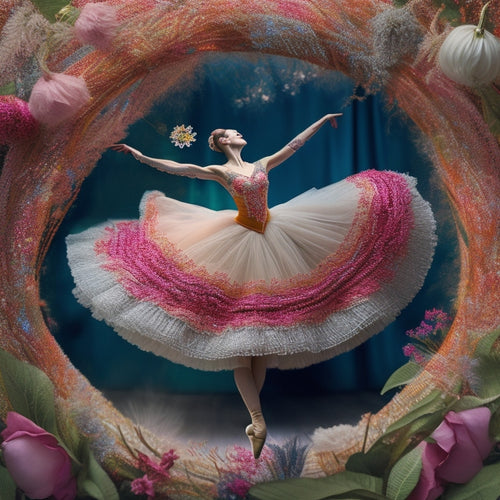
Dive Into India's Rich Cultural Mosaic
Share
India's rich cultural mosaic is a vibrant tapestry woven from a diverse array of traditions, artistic expressions, and cultural practices that have evolved over centuries. This intricate weave is reflected in its diverse folk dances, traditional music, and festivals, which bring communities together in a celebration of artistry. The country's culinary landscape is equally rich, with a diverse array of spices and regional specialties that tantalize the senses. As we explore the threads of tradition and faith, we uncover a cultural identity that is at once rooted in history and embracing of modernity, inviting us to further unravel the complexities of this fascinating cultural heritage.
Key Takeaways
• India's cultural tapestry is woven from diverse traditions, folk dances, and regional artistic expressions.
• Traditional music features complex ragas and talas, adding depth to the cultural mosaic.
• Festivals like Diwali, Holi, and Navratri celebrate cultural heritage through music, dance, and artistry.
• India's culinary landscape reflects regional diversity, with unique flavor profiles and specialties.
• Traditional attire, such as the saree and dhoti, embodies cultural identity, history, and spiritual beliefs.
Unfolding India's Cultural Tapestry
As the diverse threads of India's cultural heritage converge, a vibrant tapestry emerges, woven from the intricate patterns of ancient traditions, regional nuances, and the country's distinctive artistic expressions.
India's rich cultural tapestry is characterized by its diverse folk dances, such as Bharatanatyam and Kathakali, which showcase the country's artistic prowess. The traditional music of India, with its complex ragas and talas, adds depth to this cultural mosaic.
Festivals like Diwali, Holi, and Navratri bring communities together, celebrating the country's artistic expressions through music, dance, and artistry. These cultural manifestations not only showcase India's diversity but also highlight the nation's ability to preserve its heritage while embracing modernity.
Flavors of a Diverse Nation
India's culinary landscape, a reflection of its cultural diversity, unfolds with a rich array of spices, herbs, and regional specialties that have evolved over time, influenced by the country's historical and cultural exchanges.
The nation's culinary diversity offers a plethora of culinary adventures, with each region boasting its unique flavor profile. From the spicy curries of the south to the rich kormas of the north, every bite is a taste sensation.
The country's street food scene is equally vibrant, with popular dishes like vada pav and pani puri delighting locals and tourists alike. As you begin a gastronomic journey across India, be prepared to indulge in a kaleidoscope of flavors that will leave you craving for more.
Threads of Tradition and Faith
The intricate tapestry of Indian attire, replete with symbolic motifs and vibrant hues, weaves together the threads of tradition and faith, reflecting the nation's rich cultural heritage.
Ritualistic practices and spiritual beliefs are deeply intertwined with traditional attire, which serves as a visual representation of India's diverse religious customs.
The saree, dhoti, kurta, and turban are not just mere garments, but vessels of cultural identity, carrying the weight of history and tradition.
Each stitch, fold, and embroidery tells a story of the country's complex spiritual landscape, where Hinduism, Islam, Christianity, Buddhism, and Sikhism coexist in harmony.
As Indians don their traditional attire, they embody the nation's rich cultural mosaic, where faith and tradition converge in a beautiful dance of diversity.
Frequently Asked Questions
What Is the Significance of the Bindi in Indian Culture?
"As the adage goes, 'the eyes are the windows to the soul,' and in Indian culture, the bindi serves as a spiritual symbol, adorning the forehead, signifying marital status, spiritual growth, and beauty, often referred to as a beauty mark, adding an aura of elegance."
How Do Indian Festivals Vary Across Different Regions?
Indian festivals exhibit remarkable regional diversity, with Regional Traditions blending into Festival Fusion, sparking Cultural Revival, as Rural Celebrations and Urban Adaptations uniquely manifest, reflecting the country's rich cultural tapestry.
What Is the History Behind the Indian Sari's Evolution?
The Indian sari's evolution is a rich tapestry of ancient roots, royal influence, and fabric evolution, culminating in the Sari Revolution, where traditional styling trends merged with modern aesthetics, reflecting India's dynamic cultural heritage.
How Does Indian Classical Music Influence Modern Genres?
As the sitar's melodic whispers merge with the electric guitar's wail, Indian classical music's timeless essence infuses modern genres, birthing Raga Rock, Fusion Frenzy, and Sonic Synthesis, a Cultural Crossover of harmonies in a Melodic Mashup that redefines soundscapes.
Can Anyone Learn Traditional Indian Folk Dances?
Anyone can learn traditional Indian folk dances, leveraging body isolation, hand gestures, and rhythm patterns. With dedication to footwork fundamentals, cultural exchange can enrich understanding, and dance fusion can emerge, making this rich cultural heritage accessible to all.
Related Posts
-
Best Sustainable Athletic Wear Brands for Fitness
You deserve high-quality athletic wear that enhances your performance while being kind to the planet. Brands like Pat...
-

Design Costumes Like a Pro in 5 Essential Steps
To design costumes like a pro, start by upcycling materials and exploring thrift stores for hidden gems. Next, welcom...
-

Dance Into Creativity With Ballerina Embroidery Pattern
Ignite your creative potential with the enchanting ballerina embroidery pattern, where artistry meets precision. This...

